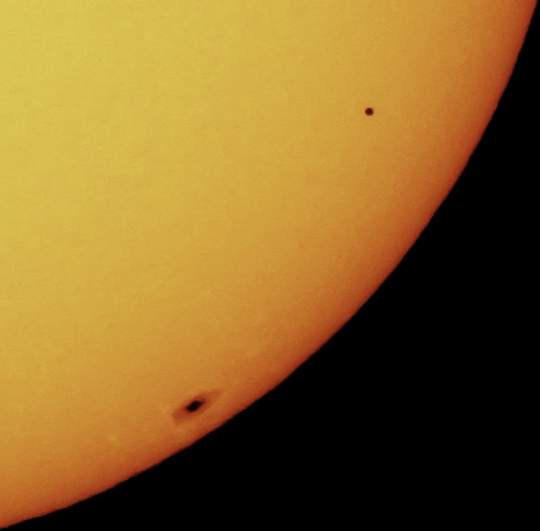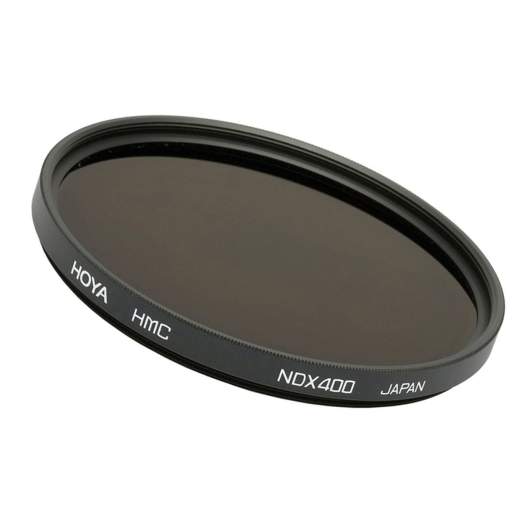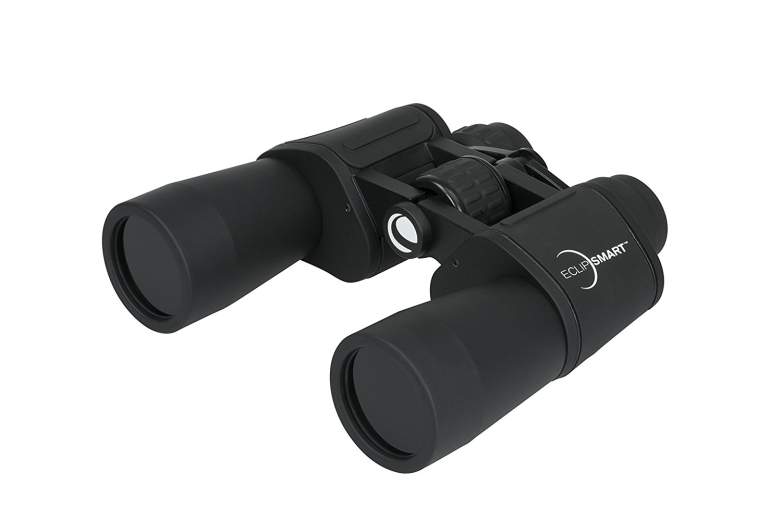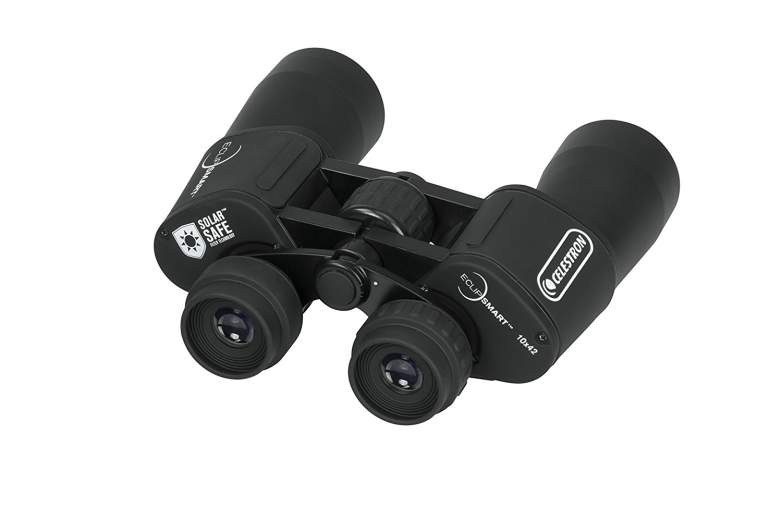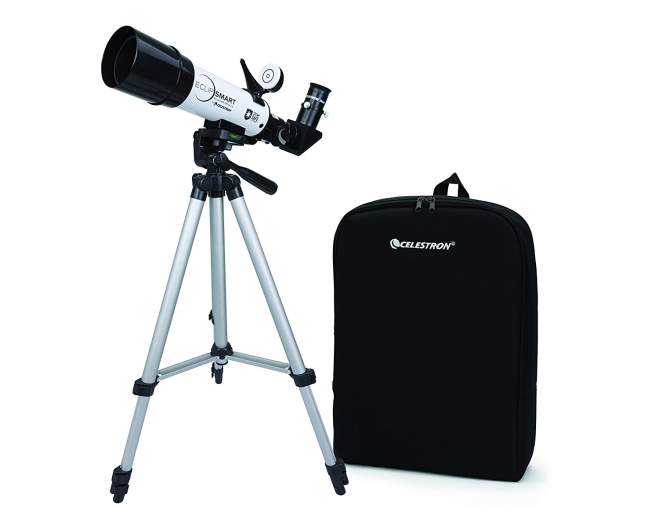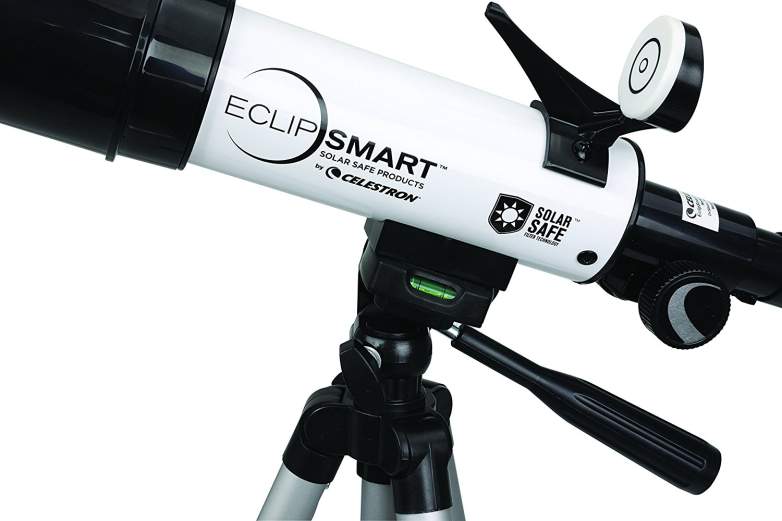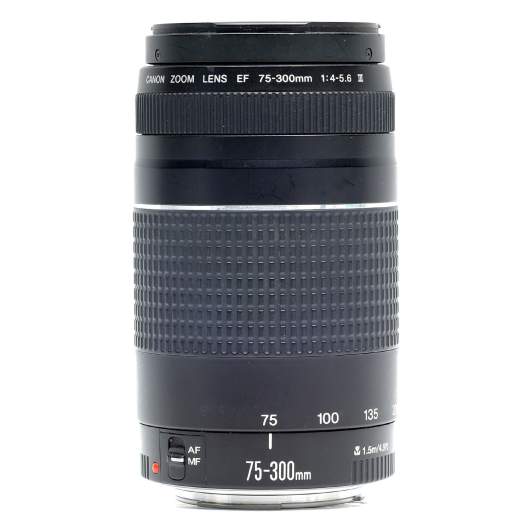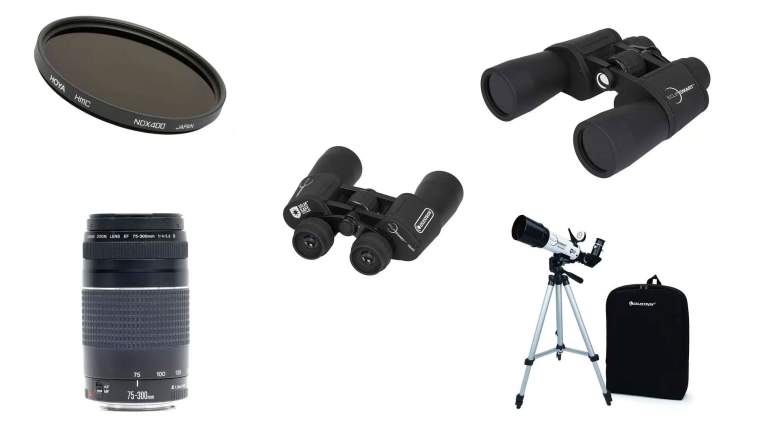
Photographing the solar eclipse is easy as long as you have the right gear for the job. There are two huge considerations when capturing this monumental and celestial event: safety and optical quality. Safety is very important and one should remember that just because the sun is blocked, one may still damage their eyes and even their equipment if proper care is not taken. While we have not listed glasses in this list, they’re an easy buy (see 5-pack on Amazon) for those who want to stay safe and stare at the sun as long as they please.
Exercise caution and you can enjoy the amazing solar eclipse for what it is: a rare and wonderful event. Here are the 5 best tools for easy photography from lowest to highest price.
1. 6″ x 6″ Solar Filter Sheet for Telescopes, Cameras, and Binoculars
This solar filter sheet is about as simple as it gets: simply tape (or otherwise secure) it to any telescope, binocular, camera, or lens and it will make a whole lot less light come in. This is an excellent way to take pictures of the sun during the eclipse since it requires learning no new equipment and lets you adapt what you already own. The sheet is big enough to be cut up and used for multiple devices and it can also be purchased in a variety of sizes including 8″ x 8″ and 10″ x 10″.
Price: $31.94
Buy the 6″ x 6″ Solar Filter Sheet for Telescopes, Cameras, and Binoculars here.
Pros:
- Great way to take extremely close up pictures of the sun
- Adaptable to any lens, telescope, binocular, or other device
- Sheet is large enough to be cut up and used on multiple devices
- Affordable and simple way to photograph or see up close images of the eclipse
Cons:
- Requires tape or other adhesive to fasten to optical device
Find more 6″ x 6″ Solar Filter Sheet for Telescopes, Cameras, and Binoculars information and reviews here.
2. Hoya 77mm ND400x Filter
This 77mm filter is a great, pro addition to any DSLR camera gear one might have. Note that 77mm filters can be stepped up or down to fit on different sized lenses (using a kit like this). This filters offers a massive reduction in your camera’s speed of about 9 stops or 1/500th. This means that one can take picture of the sun at apertures that will give more sharpness. It also means that this filter could be helpful in certain situations where one wants to shoot wide open during broad daylight. That said, it is mostly a one trick pony since 9 stops is a ton; this basically means you must be blocking out the sun. Of course, there is one other thing you can do with a filter that blocks this much light: take long exposures during the day time. It’s a two trick pony! If you have a nice DSLR, this could be a really fun way to photograph the eclipse and offers another trick shot for the vast majority of those days where eclipses aren’t happening.
Price: $69.95
Buy the Hoya 77mm ND400x Filter here.
Pros:
- Slows lens down by 9 stops (1/500 of normal speed such that 1/1000 becomes 1/500,000)
- Can be used to decrease depth of field for normal shooting situations
- Enables slow shutter speeds for light trail photography during dusk or possibly daytime (depending on camera sensitivity)
- Works with any lens given a step up or down adapter
Cons:
- May be sensitive to water damage
- Somewhat pricey for a one trick pony
Find more Hoya 77mm ND400x Filter information and reviews here.
3. Celestron EclipSmart Binoculars 10 x 42
For those who want a simple solution for getting a close-up view of the sun, binoculars are tough to beat. They’re easy to look through, focus, and get an image unlike any you’ve ever seen. These binoculars are a great deal because after you get what’s described as a “crisp and clear” view of the sun, you can also use them as normal binoculars. Note that they come in two zooming varieties; it’s recommended you opt for more zoom rather than less.
Price: $69.96
Buy the Celestron EclipSmart Binoculars 10 x 42 here.
Pros:
- Well made with solid durability
- Optics said to be exceptionally clear and crisp
- Solar filters can be separated from binocular for more general use
- Praised as providing a satisfying view of the sun
Cons:
- One user found glasses too dark to use
- A small percentage of users was dissatisfied with the zoom level (this referred to the less zooming model, the 10×25)
Find more Celestron EclipSmart Binoculars 10 x 42 information and reviews here.
4. Celestron Eclipsmart Telescope
If you’re willing to deal with the complexities of a telescope, this Celestron Eclipsmart is a great choice. Sure, it’s not as easy as binoculars, but for those who are ready to go through the focusing, weighting down (it is a bit on the light side) and adjusting process, you will be rewarded with solid quality optics and an amazing view of a star that’s been dubbed quite important to humanity. 45 times magnification is well, a ton.
Price: $93.1
Buy the Celestron Eclipsmart Telescope here.
Pros:
- Lightweight and relatively easy to set up
- Praised as afforadble yet high quality solution
- 45x magnification is a lot for this price
- Using finder is straightforward and easy
Cons:
- One user found it very cheap
- One user said mountain solar filter to existing telescope was a better idea
Find more Celestron Eclipsmart Telescope information and reviews here.
5. A Telephoto Lens
If you already have a DSLR, the truth is that without the number one item on our list (the solar filter), you can still take some pretty interesting pictures of the sun just with a telephoto lens. NOTE: You must NOT look through the lens at the sun. Fortunately, most modern DSLRs let you use a “Screen view” or “Live view” mode. This will allow you to frame your pictures as you please without looking through the viewfinder. If you do this, you can use a very high aperture value (f22) and a very high shutter speed to get a crisp picture of the sun. Some lenses that are telephoto and recommended include the Canon 75-300mm ($79.50 on Amazon), the Nikon DX 70-300mm ($123.69 on Amazon) or for iPhone, this 10x lens ($29.90 on Amazon). Adding the first item on our list, the solar sheet, to a telephoto lens, however, will yield the best results.
Note that prolonged exposures aimed at the sun can be bad and in theory, even a short one can damage your equipment. It’s better to err on the side of caution and purchase a filter, but in most cases, a brief shot shouldn’t pose any huge risk to your gear.
Price: Various
Buy and browse more telephoto lenses here.
Pros:
- Can be combined with solar filter sheet to get close-ups of the sun
- Best optical quality for a reasonable price or free if you already have one
- More share-ability for social media
Cons:
- Lens must be augmented for safely shooting pictures of the sun if one looks through the viewfinder
Find more Telephoto Lenses here.

